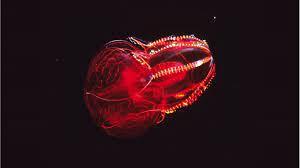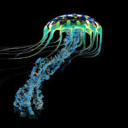An Amazing Glowing Ctenophore!
An amazing glowing ctenophore!


Bloody-belly comb jelly
Lampocteis cruentiventer
The Bloody-belly is a 16 cm ctenophore that is found at depths 700 m to 1200m. It is crimson red in color and appears black in the deep ocean. However, the jelly has the ability to emit a different color. Furthermore, it uses highly iridescent ctenes to propel through the water.
Photo credit: https://laughingsquid.com/bloody-belly-comb-jelly/
https://www.reddit.com/r/deepseacreatures/comments/2j1717/bloodbelly_comb_jelly_lampocteis_cruentiventer/
More Posts from Bioluminescentoceangoddess and Others



Black Dragonfish
Idiacanthus atlanticus
The Black Dragonfish are needle-like fish that migrate between 500m and 2000m in the deep ocean. Females are black with 6 stripes and lack a barbel, pelvic fins, and sharp teeth. Males, on the other hand, are dark brown and have a barbel, which is the light producing structure on its chin. Furthermore, it uses bioluminescence to detect prey instead of lure prey.
Photo credit: https://scitechdaily.com/scientists-learn-secrets-from-ultra-black-skin-that-allows-deep-sea-fish-to-lurk-unseen/
https://steemit.com/life/@munnashah/the-most-terrible-and-surprising-7-animals-of-the-sea
https://knowyourmeme.com/photos/995601-thalassophobia


Sea elephant
Carinaria japonica
The Sea Elephant is a translucent sea snail that has a large muscular body and a tiny triangular shell. Its foot is used for crawling on the ground, and it can be transformed into a fin that is used for swimming. It is called the “sea elephant” because it has a small trunk in its mouth that is used to swallow prey. Furthermore, the Sea Elephant eats arrow worms and jellies.
Photo credit
https://bodegahead.blogspot.com/2014/12/carinaria-part-2.html
http://tolweb.org/Carinaria_japonica/28750


Atolla Jelly
Atolla wyvillei
The Atolla Jelly is a fiery, red jellyfish that has an extraordinary display of bioluminescence. When the jelly is attacked, it uses bioluminescence to produce thousands of vibrant, blue flashes; the blue flashes act as an alarm, which draws in bigger predators and warns prey. The jelly can be found at depths between 600 m to 1500m, and it also has a long hypertrophied tentacle that aids in reproduction.
Photo credit: https://en.wikipedia.org/wiki/Atolla_jellyfish
https://en.wikipedia.org/wiki/Atolla_jellyfish


Helmet Jelly
Periphylla periphylla
The Helmet Jelly can be found at all depths of the ocean. This vibrant and strange jellyfish tends to proliferate in Norwegian fjords. They are one of the dominant predators in these isolated ecosystems.
Photos
http://www.seawater.no/fauna/cnidaria/periphylla.html
https://www.bigfishexpeditions.com/2019/01/24/norway-deepwater-shark-diving-2018/helmet-jelly/


Black-devil anglerfish
Melanoncetus johnsoni
The Black-devil anglerfish is a skilled predator that lurks in the darkness. It uses a bioluminescent organ, a top its head, to lure unsuspecting prey into its jaws. Even though these fish are terrifying to look at, they are about the size of a grape fruit. To save energy, they remain immobile in the water, yet they can detect even the slightest vibrations. Since finding a mate is hard at this depth, male fish will attach themselves to a female and slowly dissolve into her tissue; so she is able to use the sperm the male provides at any time. In addition, this is the fish that tried to eat Marlin and Dory in “Finding Nemo.”
Photo credit: https://underthevastblueseas.tumblr.com/post/40882487364/this-female-black-devil-anglerfish-with-her-flabby
https://www.pinterest.fr/pin/574631233709001328/


Gulper Eel
Saccopharynx sp.
The Gulper Eel is known for its massive jaws, which are capable of swallowing prey whole. It’s stomach is also able to expand twice its size. It is found only in the deep see about 2000 to 3000 meters in depth.
Photo credit: https://www.youtube.com/watch?v=XRO0IjSoHGA
https://marinebiochemistrygc2018.weebly.com/deep-sea-adaptations


Jewel Squid
Histioteuthis heteropsis
The Jewel Squid is covered in color-changing photophores that resemble sparkling gem stones. They also have a light-red coloration and are about 20 cm in length. They display a unique behavioral adaptation called diel migration. During the day, they stay at depths around 400-1200 m, and then surface during night (0-400m). This behavioral pattern is designed maximize feeding at night, and avoid predators during the day. The primary predator of the Jewel Squid is the Sperm Whale.
Photo credit: https://www.pinterest.com/pin/722827808920240115/
https://twitter.com/theoctonation/status/1168516522270253056

Crystal Jellyfish
Aequorea victoria
The Crystal Jellyfish is a graceful, transparent jellyfish with long, thin tentacles. It has bioluminescent organs around it bell that produce a bright, green light. It tends to consume small copepods, but it has the ability to swallow other jellyfish half its size. Furthermore, this jelly is used in biological experiments to detect calcium.
Photo credit: https://www.montereybayaquarium.org/animals/animals-a-to-z/crystal-jelly
https://fineartamerica.com/featured/5-aequorea-crystal-jellyfish-with-amphipods-alexander-semenovscience-photo-library.html


Pigbutt worm
Chaetopterus pugaporcinus
The Pigbutt worm or the flying buttocks of the sea is spotted floating between 965 m to 1300 m in the deep ocean. It is actually a polychaete (polly-keet) worm species that burrows in the ground as an adult, and floats around the ocean as a baby. The worm feeds itself : by creating a balloon of mucus; collecting particles on the mucus; and then consuming the particles. It is the rarest and thickest worm in the deep ocean, for only ten have been spotted.
Photocredit: https://roaring.earth/pigbutt-worm/
Update
Hi everyone, I apologize for the inconsistent posting. I’ve been studying for my Chemistry Praxis. :( There will be more to come soon !
-
 mycellpics reblogged this · 1 year ago
mycellpics reblogged this · 1 year ago -
 mycellpics liked this · 1 year ago
mycellpics liked this · 1 year ago -
 nerdypersonamongerscissors liked this · 1 year ago
nerdypersonamongerscissors liked this · 1 year ago -
 stardustandmoonflowers liked this · 1 year ago
stardustandmoonflowers liked this · 1 year ago -
 maxinji liked this · 2 years ago
maxinji liked this · 2 years ago -
 hairlice reblogged this · 2 years ago
hairlice reblogged this · 2 years ago -
 thezenofbrutality liked this · 2 years ago
thezenofbrutality liked this · 2 years ago -
 horsebrain liked this · 2 years ago
horsebrain liked this · 2 years ago -
 couldhavechoosensthbetter liked this · 2 years ago
couldhavechoosensthbetter liked this · 2 years ago -
 itsketo-voyaging reblogged this · 2 years ago
itsketo-voyaging reblogged this · 2 years ago -
 dead-n-cide reblogged this · 2 years ago
dead-n-cide reblogged this · 2 years ago -
 dead-n-cide liked this · 2 years ago
dead-n-cide liked this · 2 years ago -
 saltmatchescandlewax reblogged this · 2 years ago
saltmatchescandlewax reblogged this · 2 years ago -
 anemonether liked this · 2 years ago
anemonether liked this · 2 years ago -
 awthorne reblogged this · 3 years ago
awthorne reblogged this · 3 years ago -
 unknown-daddy liked this · 3 years ago
unknown-daddy liked this · 3 years ago -
 owlservice liked this · 3 years ago
owlservice liked this · 3 years ago -
 redwolf1999 liked this · 3 years ago
redwolf1999 liked this · 3 years ago -
 battlemage94 liked this · 3 years ago
battlemage94 liked this · 3 years ago -
 sothatidostuff reblogged this · 3 years ago
sothatidostuff reblogged this · 3 years ago -
 shiny-aesthetic liked this · 3 years ago
shiny-aesthetic liked this · 3 years ago -
 blueorandas reblogged this · 3 years ago
blueorandas reblogged this · 3 years ago -
 blueorandas liked this · 3 years ago
blueorandas liked this · 3 years ago -
 cass-and-ras-world liked this · 3 years ago
cass-and-ras-world liked this · 3 years ago -
 aravenrebellion liked this · 3 years ago
aravenrebellion liked this · 3 years ago -
 aeshnacyanea2000 reblogged this · 3 years ago
aeshnacyanea2000 reblogged this · 3 years ago -
 funkypeach77 liked this · 3 years ago
funkypeach77 liked this · 3 years ago -
 cum--brulee liked this · 3 years ago
cum--brulee liked this · 3 years ago -
 snickeringdragon liked this · 3 years ago
snickeringdragon liked this · 3 years ago -
 beautyinthebadthings reblogged this · 3 years ago
beautyinthebadthings reblogged this · 3 years ago -
 beautyinthebadthings liked this · 3 years ago
beautyinthebadthings liked this · 3 years ago -
 psionic--drain liked this · 3 years ago
psionic--drain liked this · 3 years ago -
 localwarlockunion liked this · 3 years ago
localwarlockunion liked this · 3 years ago -
 420champ liked this · 3 years ago
420champ liked this · 3 years ago -
 nightmaregorepng liked this · 3 years ago
nightmaregorepng liked this · 3 years ago -
 wannabe-etymologist reblogged this · 3 years ago
wannabe-etymologist reblogged this · 3 years ago -
 sewer-dweller liked this · 3 years ago
sewer-dweller liked this · 3 years ago -
 lackluster-rat liked this · 3 years ago
lackluster-rat liked this · 3 years ago -
 despair-with-walnuts liked this · 3 years ago
despair-with-walnuts liked this · 3 years ago -
 slime-gargoyyyle liked this · 3 years ago
slime-gargoyyyle liked this · 3 years ago -
 v-o-f-k liked this · 3 years ago
v-o-f-k liked this · 3 years ago -
 gothfrog-44 liked this · 3 years ago
gothfrog-44 liked this · 3 years ago -
 druidwolf25 liked this · 3 years ago
druidwolf25 liked this · 3 years ago -
 trucko1000 liked this · 3 years ago
trucko1000 liked this · 3 years ago -
 teethandblood liked this · 3 years ago
teethandblood liked this · 3 years ago

Bioluminescence is a chemical reaction that produces light. Many deep sea animals use bioluminescence. This blog is dedicated to educating the public about the amazing creatures that thrive in the deep sea.
57 posts